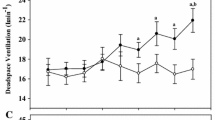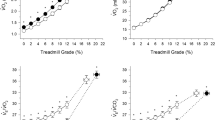Summary
The effects of a filtering device, an air-line breathing apparatus and a self-contained breathing apparatus (SCBA) on pulmonary ventilation, oxygen consumption and heart rate were studied in 12 well-trained firemen aged 21–35 years. Their average maximal oxygen consumption (\(\dot V_{{\text{O}}_{\text{2}} }\) max) was 64.9 ml·min−1·kg−1. Sequential tests without and with the respirator were performed on a treadmill. The continuous test contained five components, each of which lasted 5 min: sitting at rest, walking at 20%, 40%, and 60% of the individual\(\dot V_{{\text{O}}_{\text{2}} }\) max, and recovery sitting. During the higher submaximal work levels and recovery, ventilation, heart rate, and oxygen consumption in particular increased more with respirators than without them. At the highest work level the increments in oxygen consumption caused by the respirators were 13%, (8.7 ml·min−1·kg−1), 7% (4.4 ml·min−1·kg−1), and 20% (12.7 ml·min−1·kg−1) of\(\dot V_{{\text{O}}_{\text{2}} }\) max. All three respirators hampered respiration, resulting in hypoventilation. The additional effort of breathing and the weight of the apparatus (15 kg with the SCBA) increased the subjects' cardiorespiratory strain so clearly that the need for rest periods and the individual's work capacity when the respirators are worn must be carefully considered, particularly with the SCBA.
Similar content being viewed by others
References
Barlett HL, Hodgson JL, Kollias J (1972) Effect of respiratory breathing valve dead space on pulmonary ventilation at rest and during exercise. Med Sci Sports 4: 132–137
Borghols EAM, Dresen MHW, Hollander AP (1978) Influence of heavy weight carrying on the cardiorespiratory system during exercise. Eur J Appl Physiol 38: 161–169
Cerretelli P, Sikand RS, Farhi LE (1969) Effect of increased airway resistance on pulmonary ventilation and gas exchange during exercise. J Appl Physiol 27: 597–600
Craig FN, Blevins WV, Cummings EG (1970) Exhausting work limited by external resistance and inhalation of carbon dioxide. J Appl Physiol 29: 847–851
Dressendorfer RH, Wade CE, Bernauer EM (1977) Combined effects of breathing resistance and hyperoxia on aerobic work tolerance. J Appl Physiol 42: 444–448
Epstein Y, Keren G, Lerman Y, Shefer A (1982) Physiological and psychological adaptation to respiratory protective devices. Aviat Space Environ Med 53: 663–665
Gee JBL, Vassallo BC, Gregg J (1968) Effects of external airway obstruction on work capacity and pulmonary gas exchange. Am Rev Respir Dis 98: 1003–1012
Gordon MJ, Goslin BR, Graham T, Hoare J (1983) Comparison between load carriage and grade walking on a treadmill. Ergonomics 26: 289–298
Hermansen L, Vokac Z, Lereim P (1972) Respiratory and circulatory response to added air flow resistance during exercise. Ergonomics 15: 15–24
Holmer I, Arvidsson S (1975) Arbete i gasskyddstrÄkt. Arbete och hÄlsa nr. 7. Arbetarskyddsverket, Stockholm
Johnson AT (1976) The energetics of mask wear. Am Ind Hyg Assoc J 37: 479–488
Jones NL, Levine GB, Robertson DG, Epstein SW (1971) The effect of added dead space on the pulmonary response to exercise. Respiration 28: 389–398
Kelman GR, Watson WS (1973) Effect of added dead-space on pulmonary ventilation during sub-maximal steady-state exercise. Q J Exp Physiol 58: 305–313
Raven PB, Davis TO, Shafer CL, Linnebur AC (1977) Maximal stress test performance while wearing a self-contained breathing apparatus. J Occup Med 19: 802–806
Raven PB, Dodson AT, Davis TO (1979) The physiological consequences of wearing industrial respirators: A review. Am Ind Hyg Assoc J 40: 517–534
Sackner JD, Nixon AJ, Davis B, Atkins N, Sackner MA (1980) Effects of breathing through external dead space on ventilation at rest and during exercise. II. Am Rev Respir Dis 122: 933–940
Schleusing G, Ohl R (1967) Untersuchungen über auftretende Erschwernisse bei dem Tragen von AtemschutzgerÄten. Int Z Angew Physiol 24: 81–101
Silverman L, Lee G, Plotkin T, Sawyer LA, Yancey AR (1951) Air flow measurement on human subjects with and without respiratory resistance at several work rates. Arch Ind Hyg Occup Med 3: 461–478
Slonim NB, Bell BP, Christensen SE (1974) Cardiopulmonary laboratory basic methods and calculations, a manual of cardiopulmonary technology. Charles C Thomas, Springfield
Wasserman K, Whipp BJ, Koyal SN, Beaver WL (1973) Anaerobic threshold and respiratory gas exchange during exercise. J Appl Physiol 35: 236–243
Author information
Authors and Affiliations
Rights and permissions
About this article
Cite this article
Louhevaara, V., Tuomi, T., Korhonen, O. et al. Cardiorespiratory effects of respiratory protective devices during exercise in well-trained men. Europ. J. Appl. Physiol. 52, 340–345 (1984). https://doi.org/10.1007/BF01015224
Accepted:
Issue Date:
DOI: https://doi.org/10.1007/BF01015224




